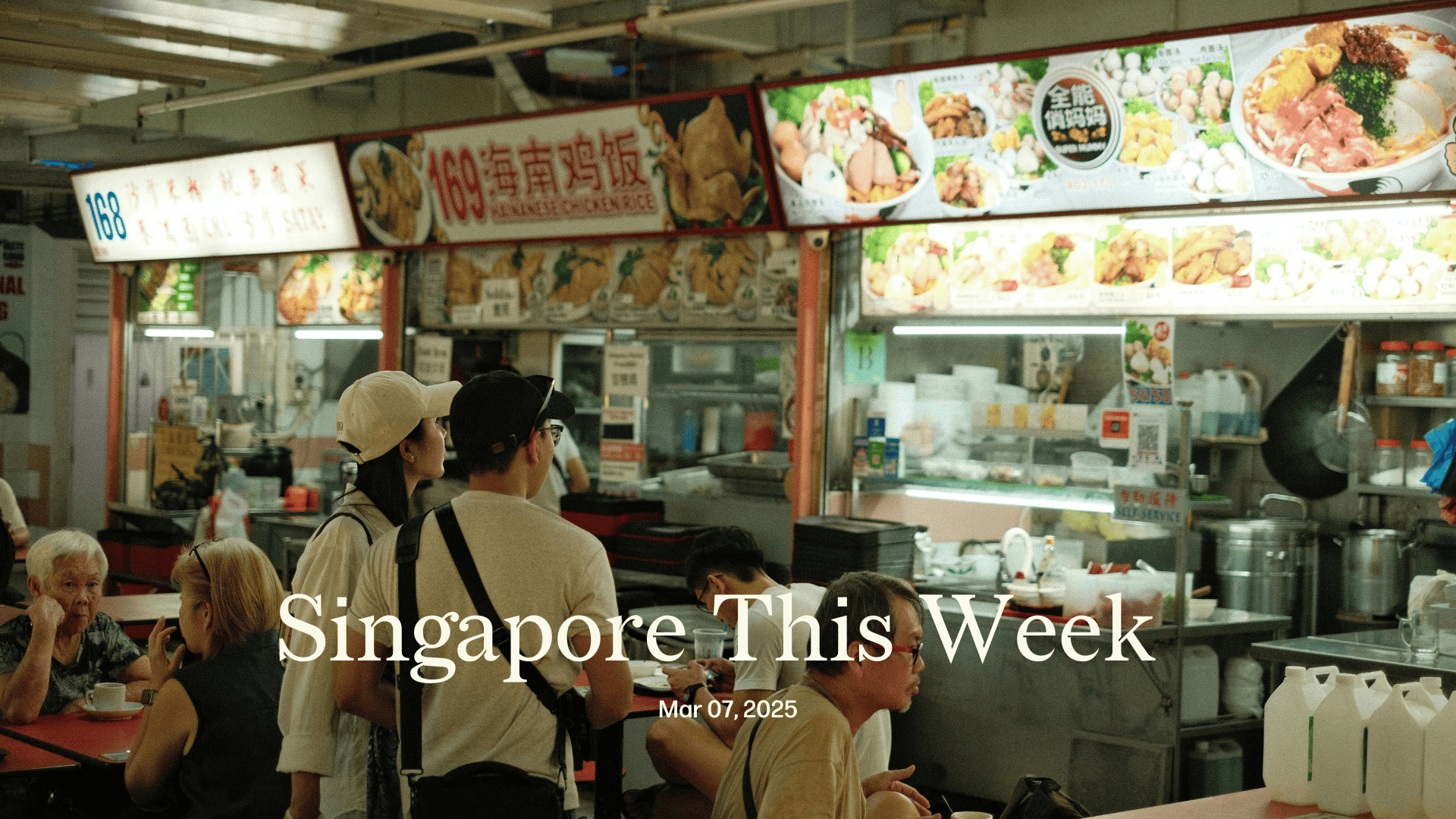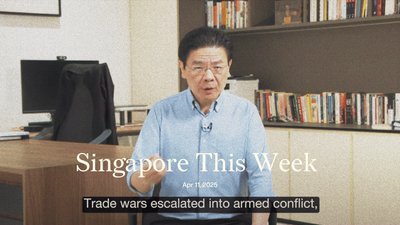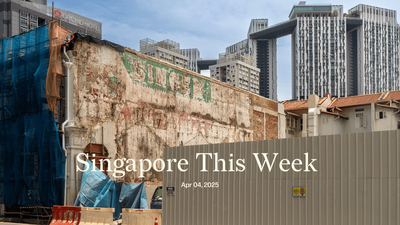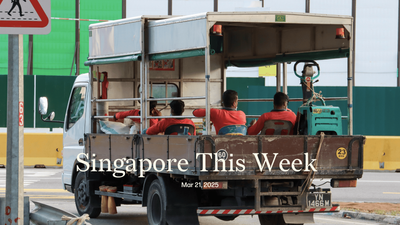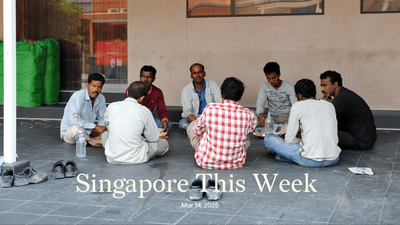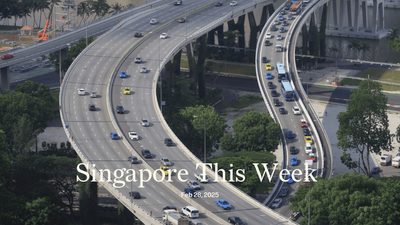Politics: Peanuts for peasants
Lawrence Wong, prime minister, appears to be losing the cost-of-living debate. The clearest sign is that he’s felt compelled to publish on social media a new video on the Budget to augment the numerous ones from Parliament online. He said little new, though predictably succeeded in generating fresh churnalism from the mainstream media—important, because the ruling People’s Action Party (PAP) will hope that voters remember Wong’s messaging rather than the description by Pritam Singh, leader of the Workers’ Party, that the PAP had been “turbocharging” inflation through recent hikes in the goods and services tax (GST).
But was there turbocharging? Wong accused Singh of turning Parliament into an “election rally”, and getting “carried away by hyperbole”. Jamus Lim, economist and WP member of Parliament (MP), responded this week with an accessible primer on how various fiscal initiatives—such as GST hikes and the issuance of CDC vouchers—might ultimately affect prices. He concluded that the GST hike contributed 20 percent of 2023’s inflation and 40 percent of 2024’s. “I’ll let folks decide for themselves if this contribution to inflation was significant.” Perhaps it’s just perspective. For ministers surrounded by Bentleys and Maseratis, they’re used to proper turbos; for politicians in Aljunied and Sengkang, sikit power and they’ll call it a turbo.
But why did the government hike rates despite its huge surplus? Even if they were necessary as part of a fiscally responsible approach—why now, when so many are hurting? This is the more salient criticism that Wong has had trouble dealing with. In the video he explained the government’s conundrum: emerging from Covid-19, unsure “how deep a fiscal hole we would end up with”, unsure about rising healthcare costs in an ageing society. Donald Low, an economist at the Hong Kong University of Science and Technology, said that there’s a strong case for “fiscal marksmanship”, and repeated a point first made in 2015, that “persistently understating surpluses or overstating deficits may also undermine trust in government and cause people to be cynical when the government (or its self-appointed apologists) defend a tax increase.”
This cynicism should worry the PAP. Whatever the merits of Singapore’s past fiscal prudence, voters increasingly perceive its leaders as millionaire elites who, oblivious to the struggles of the hoi polloi, unnecessarily keep tightening our belts even as they gorge. After K Shanmugam, law and home affairs minister, reposted a PAP apologist’s take on the budget, one Redditor responded: “The Rajah of Ridout trying to tell us peasants why the cost of living isn’t that bad and has been solved by the peanuts his government gave out. fuck off back to your GCB [good class bungalow].”
Politics: A Prof and a Pole hop into bed
It’s not just the open debates between politicians that are intriguing in the lead up to Singapore’s general election (GE), but also the veiled skirmishes between commentators online. Last week, Ben Leong, a computer science professor at the National University of Singapore, attempted to rebut Singh’s suggestion of “turbocharging” with “simple Math”: using an anecdote of the effect of a GST hike on coffee prices. Like a certain know-it-all in the White House, Leong has a penchant for parachuting himself into unfamiliar terrain and then using folksy language to try and demystify complex topics. He cited “fact-checking” by Critical Spectator, the nom de guerre of Michael Petraeus, a Polish visitor to Singapore whose primary objective seems to be endearing himself to the PAP by demeaning its critics.
The takedowns of Leong and Petraeus this week by Lim and Low, economists who’ve actually studied inflation, are worth reading for their cogency, humour, and obliqueness. Neither mentions Leong or Petraeus by name. “Self-appointed apologists,” Low sneered, probably aware that they’re doing much harm to Wong. “Before anyone appoints himself as a fact-checker, they should do themselves a favour…”
“I do not generally get irritated by things folks say on the Internet,” Lim began, clearly in response to Leong’s vacuous musings. “...it may be useful explaining why the macroeconomic effects of tax changes are more complicated than more simplistic analyses would suggest.”
That Lim and Low felt it necessary to even respond speaks to Leong’s and Petraeus’s influence. Indeed, their views are regularly re-posted by the PAP’s senior-most members. But are Leong and Petraeus helping or hurting the PAP? Firebrands may rouse the faithful, but scare off the rest.
Sign up for Jom’s weekly newsletter
Our newsletters combine weekly updates about Singapore with a "build-in-public" narrative, in which we tell readers about our start-up journey.
No spam. Unsubscribe anytime.
Politics: Danger, danger, everywhere
The PAP may be losing the cost-of-living debate, but it can always count on its tried-and-tested campaigning on Singapore’s supposed vulnerability. In the early days of independence, the narrative was that we are like “Israel in a Malay-Muslim sea”. In recent years, it’s been grounded more in the risks associated with the so-called end of the liberal order, including deglobalisation and tensions in the South China Sea. Donald Trump’s victory last November is thus a double-edged sword for the PAP. The chaos from the US’s retreat from the world might hurt Singapore, a “small state” in the Great (geopolitical) Game, and a highly trade-dependent one; but that might also, electorally, help the PAP if it results in a flight-to-safety vote at the GE. Although cost-of-living and other prosaic concerns ranked highly in the Jom voter sentiment survey last year, a fifth of Singaporeans also cited “geopolitical tensions” as a pressing political issue.
Wong has repeatedly warned of a “far more dangerous world” and this past week Vivian Balakrishnan, minister for foreign affairs, dropped the word “danger” ten times in a speech to Parliament. (More below, in our history blurb.) He mentioned three core strengths that will help us deal with geopolitical headwinds: economic strength; defence capabilities; and unity. Importantly, he acknowledged the fact that our political diversity doesn’t affect our outward orientation. “I want to thank the Opposition that so far, we have worked on the basis that politics stops at the water’s edge.”
This is true for many feisty multi-part democracies around the world, including South Korea and Taiwan. Yet in Singapore the belief in our inherent vulnerability remains strong, and the likelihood is that PAP will veer towards it while campaigning. To make sense of the upcoming GE, it’s not just domestic issues we must watch, but also the actions of the White House.
Some further reading: “Prospects for Multilateralism at the End of the Liberal Order” by Joel Ng of the S. Rajaratnam School of International Studies (RSIS) at the Nanyang Technological University (NTU).
Society: Flush with cash
Two grants, worth S$5m each, will soon be available to coffee shop owners to cover up to 95 percent of costs when they renovate and/or deep clean their public toilets. They’re capped at S$50,000 and S$25,000 respectively per coffee shop. Successful applicants also receive free on-site toilet cleaning training for in-house cleaners. More details about the grants—among a list of 10 recommendations by the Public Toilets Task Force—are forthcoming later this year, said the Ministry of Sustainability and the Environment.
Singapore’s recognised as a “clean and green” city. But this global repute loses its sheen in the notoriously filthy and fetid public toilets of neighbourhood coffee shops and hawker centres, where hygiene levels appear to be worsening. Over the years, islandwide surveys of thousands of public toilets conducted by the Singapore Management University attest to this (open) dirty secret. Surprising perhaps, given that it’s been some 40 years since the country’s first Keep the Toilet Clean campaign. Recent efforts to change piss-poor behaviour include the Clean Public Toilets Campaign launched in 2018 that ran for five years, and 2024’s Cleaner Public Toilets Campaign in the Year of Public Hygiene. More than 1,200 enforcement actions—such as fines and warnings—were taken against premises owners for public toilet lapses last year, up from 367 the year before. Wet floors; absent, dirty or overflowing rubbish bins; unclean toilet bowls and seats; choked urinals; and inadequate or absent toilet paper continue to sully the island’s communal restrooms. “It’s a running joke that Singapore isn’t a clean society: We are a cleaned society,” wrote William Wan of the Singapore Kindness Movement.
Public bathrooms are more than functional. Historically, they’ve been “significant sites of overt and covert political struggles”, playing a pivotal role in social justice movements. Toilet equity and potty parity ensures equality of access to free public conveniences—the lack of which disproportionately affects disadvantaged groups: people with disabilities, women, the elderly, outdoor workers, rough sleepers, children, and transgender individuals. Dignity through access embraces health, safety and mobility, allowing for social participation and the enjoyment of public spaces. We can start by paying cleaners a better wage, one that reflects the essential service they provide. Acceptable public loo hygiene should not be limited to hotels, restaurants and shopping malls. Keeping public toilets clean must be everyone’s business; our moral and civic duties as users, caretakers and owners.
Society: Reducing e-commerce waste
Pulau Semakau and Pulau Seking, two islands about eight kilometres south of the mainland, were home to fishing communities for hundreds of years. In 1991, explorers to Semakau found pieces of pottery dating back to the early 1800s; and even one believed to be from the 12th century. “Their [the inhabitants’] knowledge of their environment, the tides, the plants, was intimate; they could tell the weather from the ripples in the sea and the changing hues of the skies,” said Normala Manap, an ethnographer.
In 1994, the government relocated the islands’ last few residents, linked the two islands, and cordoned them off from the ocean with a seven-kilometre embankment. Coral reefs in east Semakau, “less spectacular” than the ones in the west, were lost. And so was born the Semakau Landfill: the place that holds the detritus of our hyper-consumptive, hyper-urbanised economy. The landfill’s operations began in 1999, and was expected to serve our dumping needs until 2045. However, it is now anticipated that Singapore’s sole landfill will reach maximum capacity a decade earlier. In a bid to extend Semakau’s life, the government hopes to reduce the amount of annual waste—more than 750,000 tonnes—sent to it by 20 percent by 2026; and by 30 percent by 2030. But the figure has not budged in the past seven years.
Now, new packaging guidelines have been introduced to minimise e-commerce waste. In 2023, Singaporeans received 186,000 parcels. Every day (on average). Over the year, they added up to 15,900 tonnes of garbage with much of it ending up in Semakau. The guidelines, developed in partnership with industry, call for a reduction in the amount of packing material and the use of eco-friendly alternatives where feasible. Examples include shredded cardboard instead of plastic bubble wrap as protective filler, and paper-based tape instead of scotch tape. Such public-private partnerships are laudable if they lead to actual change. But the onus is on us regular folks too. “It’s a pity that people of this generation no longer get to experience these cultures and ways of life that are integral parts of our history and who we are today,” said Manap, the ethnographer, of the erstwhile communities on Semakau and Sekang. In an economy based on relentless consumption, it’s not just goods we end up devouring.
History weekly by Faris Joraimi
Singaporean statesmen know these aren’t just interesting times, but an epochal turning point. At the last Committee of Supply debate, both Ng Eng Hen and Vivian Balakrishnan, ministers of defence and foreign affairs respectively, spoke about the unprecedented breakdown of the international liberal order. The world increasingly resembles the one that existed in the 1930s: trade wars, protectionism, the rise of populist nationalism, increasingly frequent wars of aggression. “We sit here and we watch the events,” Ng said, “No one can predict the future precisely, but the feel of change is in the air.” He took the House through events from the dark days before international law, when strong nations did as they wished and the weak suffered: from the Anglo-Dutch Treaty of 1824 to the Sykes-Picot Agreement that carved up the Ottoman empire in 1916.
The sober, even sombre tone of both speeches marks a change from the self-congratulation we used to hear more often about Singapore reaching the end of history by joining the “First World”. We’re realising that our economic miracle was not fate, destiny, or one man’s genius; it was underwritten by Pax Americana following world war two, when states prospered by being in the orbit of the US empire. The party is ending, as Balakrishnan put it: “This is not merely a sudden temporary change in diplomatic weather. This is geostrategic climate change.” His speechwriter must feel damn shiok.
Let’s be clear here: things were terrible for many countries under the US-led postwar order. Democratically elected rulers were toppled by the CIA, which propped up ruthless tyrants. International law? States that refused to step in line were invaded and occupied. And do all nations really have an equal voice at the UN? The whole set-up was good for Singapore, of course; someone somewhere always pays the price for your comfort. We’re constantly reminded to see the world as it is and not what we want it to be, to uphold principles and not take sides. But what if the world as it is makes principles impossible to uphold, and one where we are compelled to take sides? What does putting “national interests” first mean when our fortunes and survival are so intertwined with that of so many others on whom we depend? Before modern borders and surveillance, our region’s mode of politics was based on maintaining loyalties, relationships, and a broad conception of justice. Are we willing to be students of that history? “Just as a lark,” said Ng in his speech, “I typed in to ChatGPT and said, what would happen to Singapore if we were under Dutch rule? It gives you a very good answer.” May we not mistake a machine’s hallucinations for history lessons.
Arts: God, it’s brutal out here
It may have lost the Best Picture race at the Oscars, but you can still marvel at the architecture of “The Brutalist” right here in Singapore. The sumptuous period saga follows the arduous journey of László Tóth, a Hungarian Jewish emigre and Holocaust survivor (played by Adrien Brody), as he struggles to make a living in the post-war US. The film’s greatest feat, however, may well have been the conjuring of a staggering architectural edifice that doesn’t actually exist. Tóth’s magnum opus, both minimalist and maximalist, falls squarely into the style of brutalist architecture that was also favoured by modernist architects here in the 1970s. Austere and severe, you’ll recognise these buildings by their exposed concrete, stodgy geometric contours, and monochromatic colour palettes. Brutalism as an architectural movement emerged from the European reconstruction projects of the post-war era and, in Singapore, from the urban renewal of the 1960s and 1970s that saw thousands of squatters moving from slums into the angular and anonymous public housing blocks the nation-state is known for today. We’ve always had a great fondness for these utilitarian undertakings. Consider the horseshoe stack of the former Pearl Bank Apartments, its raw concrete facade separating it from a skyline of steel and glass. Or the octagonal fortress of the former State Courts Building (now housing the Family Justice Courts), with its alternating bands of dark recessed windows and white masonry walls.
One of the brutalist icons in the recent spotlight has been Golden Mile Complex, the landmark along Beach Road that will soon become even more of a megastructure. Its original architects have been summoned back to rejuvenate the large-scale, strata-titled development, which was gazetted for conservation in 2021. Just last year, the Urban Redevelopment Authority greenlit the addition of four storeys of office space, and a neighbouring 45-storey luxury residential property. DP Architects is keeping some original architectural features, such as the stepped terraced design and porthole windows of its exterior, and the slanted mosaic tile floorings and cavernous central atrium of its interior. But while its structural heritage has been preserved, Golden Mile Complex has shed its former personality. Singapore’s “Little Thailand” is long gone, and with it, its cheap eateries, seedy karaoke bars and specialty sundry stores. And its new gilded age is already here. The towering Aurea (from aurum, Latin for “gold”), will start booking sales this weekend. Only those with the Midas touch need apply, with prices starting at S$1.92m for a two-bedder. But if you’re missing the scrappy feel of the twin Golden Miles, you can always head to The Projector, the indie cinema in Golden Mile Tower next door, to catch “The Brutalist” on the silver screen.
Some further reading: In “Love and loss in modernist times: goodbye Golden Mile Complex and Peace Centre”, a Jom photo essay bids farewell to two iconic 1970s shopping malls.
Tech: The semiconductor smuggling plot thickens
The ongoing investigations into alleged fraud involving Nvidia’s semiconductor chips have brought Singapore and Malaysia into the spotlight. Singapore authorities have charged three men suspected of illegally transferring these chips, embedded in Dell and Supermicro servers, to Malaysia. The final destination is suspected to be DeepSeek, a Chinese AI firm whose Large Language Model (LLM) has recently gained significant attention. The charges are part of a larger investigation into 22 individuals and companies suspected of using false representations to circumvent US export controls on the movement of AI chips to China.
“The question is whether Malaysia was a final destination or from Malaysia, it went to somewhere else, which we do not know for certain at this point,” said Shanmugam. Meanwhile, Tengku Zafrul Aziz, Malaysia’s trade minister, reported no evidence of unauthorised chip usage among major data centre operators in the country, even as authorities there continue to probe the chips’ final destinations. The resolutions of these cases will significantly impact future regulatory measures, reflecting the need for robust international cooperation to secure global technology ecosystems. The investigations also highlight the challenges for semiconductor trading hubs like Singapore and Malaysia, caught as they are in the broader geopolitical battle between larger powers US and China.
If you enjoy Jom’s work, do get a paid subscription today to support independent journalism in Singapore.

